🌍 Mauritius – A Poem of Islands, Cultures & Time 🌺
Jun 18, 2025-by sansheo@yahoo.com in Travel and Culture
Discovery
Mauritius is a small island in the Indian Ocean, but its history is rich and fascinating. Long before the first Europeans arrived, Arab and Malay sailors had already discovered the island around the 10th century.
The History of Mauritius Before and After Independence in 1968

Introduction to Mauritius
This Beautiful Island is situated in the Indian Ocean, This diverse archipelago is situated approximately 2,000 kilometers off the South African mainland The geography of Mauritius comprises volcanic terrain, lush forests, and coral reefs, making it a significant site for biodiversity. The island is known for its rich cultural tapestry, resulting from centuries of interaction between various ethnic groups, including African, Asian, European, and Creole communities.
The colonial history of Mauritius significantly shaped its modern identity. Initially discovered by the Portuguese in the 16th century, the island later came under Dutch, French, and British rule. Each colonial power left an indelible mark on the island’s social, economic, and cultural fabric. At the culmination of British colonial rule in the mid-20th century, Mauritius began to chart its course toward independence. The influences of colonialism on Mauritius remain visible today, encompassing aspects such as the legal system, language, and education, which are reflective of its diverse past.
Understanding the historical context of Mauritius is crucial for appreciating its evolution into a modern democratic state. The events that transpired before and after independence in 1968 continue to resonate in today’s Mauritius, influencing how the nation views its multi-ethnic society and governance. This brief overview of Mauritius highlights the geographical significance and cultural diversity that define the island. It prepares the reader for an in-depth analysis of the pivotal events that shaped the nation’s road to independence and the implications of this transition on its development.
Colonial Era: A Key Phase in Mauritian History
The history of Mauritius during the colonial era is a pivotal chapter that shaped the island’s demographics, economy, and social structures. The story begins in the 17th century with the arrival of the Dutch, who were the first Europeans to set foot on the island in 1638. Although the Dutch established a settlement, their lack of sustainable agricultural practices and severe weather conditions ultimately led to their withdrawal in 1710. This initial phase introduced the seeds of colonial influence, albeit transiently.
In the early 18th century, the French claimed Mauritius, renaming it Île de France. The French colonization marked a defining transformation in the island’s agricultural landscape, notably with the introduction of sugar cane cultivation, which became the backbone of the Mauritian economy. The French implemented a plantation system that relied heavily on enslaved labor, leading to significant demographic changes as enslaved Africans and later indentured laborers from India were brought to work the fields By (Mahe De Labourdonais). This system laid the groundwork for a multicultural society, which would come to define Mauritius in the subsequent periods.
With the Napoleonic Wars leading to France’s defeat, the British took control of Mauritius in 1810. British rule further redefined the island’s social and economic frameworks. The abolition of slavery in 1835 necessitated a new labor force, prompting the migration of Indian workers, which added another layer to the multicultural fabric of the nation. The British also established new governance systems and improved infrastructure, though the socio-economic disparities among the various ethnic groups remained a significant issue.
Overall, the colonial era was a crucial phase in Mauritian history, influencing its demographic diversity and shaping its economic development through agricultural practices. The legacies of these colonial powers continue to impact the island’s identity and societal structures to this day.
The Evolution of a Multi-Ethnic Society
The cultural landscape of Mauritius is remarkably diverse, shaped by a rich tapestry of ethnic groups throughout its colonial history. Initially inhabited by the Dutch, then later colonized by the French and British, the island witnessed significant demographic changes that enriched its society. The arrival of enslaved Africans in the 17th and 18th centuries marked the beginning of a profound transformation. These individuals were brought to work in the Agricultural sectors, particularly in the sugar and Tea industries leading to the emergence of a vibrant Creole community that contributed to the island’s distinctive identity and cultural practices.
Following the abolition of slavery in 1835, the colonial administration sought a new labor source to sustain the economy. This led to the introduction of indentured laborers from India, predominantly Hindus and Muslims, who migrated en masse to Mauritius between 1834 and 1910. Their arrival significantly impacted the demographic composition of the island. The Indian community established robust cultural and religious traditions that still thrive today, enriching Mauritius’ multicultural ethos. Festivals such as Diwali and Holi became integral aspects of the island’s social calendar, showcasing the coexistence of diverse beliefs and practices.
Moreover, the Chinese community also played a significant role in shaping Mauritian society. Migrating primarily in the 19th century, Chinese immigrants have contributed economically, particularly through trade and entrepreneurship. They established a unique cultural presence, introducing distinct culinary traditions that now form an essential part of Mauritian cuisine. This blend of influences demonstrates how various groups—Africans, Indians, Chinese, and Creoles—have intermingled, creating a harmonious yet complex societal framework. The unifying theme is the interdependence of these communities, highlighting the transformative power of multiculturalism in forging the national identity of Mauritius.
The Road to Independence: Political Movements and Resistance
The journey towards independence for Mauritius was characterized by a number of political movements with the support of public with a significant resistance against colonial rule. In the early 20th century, the Mauritian populace began to develop a strong sense of national identity, driven primarily by the desire for self-determination and the end of colonial domination. The rise of nationalist sentiments coincided with global trends advocating for independence across several nations, which inspired local leaders to mobilize citizens against the British administration.
One of the cornerstone developments during this period was the formation of various political parties, with the Labour Party emerging as a notable force in the 1930s. Spearheaded by influential figures like Sir Seewoosagur Ramgoolam, this party aimed to mobilize workers and the general populace by addressing their grievances, particularly concerning socio-economic inequalities and discriminatory practices entrenched in colonial governance. Ramgoolam became a vital figure, effectively articulating the aspirations of the masses while fostering unity among the diverse ethnic communities in Mauritius. His leadership was pivotal in galvanizing support for independence, and his relentless advocacy laid the foundation for future negotiations.
In addition to orchestration within political parties, the struggle for independence also witnessed significant grassroots movements. Various protests and demonstrations emerged throughout the 1950s and 1960s, echoing demands for political reform and greater political representation. These movements reflected the growing discontent among Mauritians about colonial policies and socioeconomic disparities. The tireless efforts of these activists were instrumental in raising political consciousness and mobilizing a collective fight against British imperial rule.
By the time the island moved toward eventual independence in 1968, it was clear that the actions of various political movements, leaders, and the populace collectively had forged a robust front against colonialism. Sir Seewoosagur Ramgoolam, along with his contemporaries, played a crucial role in navigating this transformative period, ultimately paving the way for a sovereign Mauritius.
Independence Day: The Momentous Year of 1968
March 12, 1968, marks a pivotal moment in the history of Mauritius as it transitioned from a British colony to an independent nation. The process towards independence began many years earlier, characterized by political movements and social changes that laid the groundwork for self-determination. The culmination of these efforts was celebrated nationwide with significant favor. In towns and villages across the island, people gathered to participate in festivities that embodied a newfound sense of identity and nationalism.
The day of independence(12 March 1968) itself was filled with ceremonies marking the formal end of colonial rule. At the stroke of midnight, the Union Jack was lowered for the last time, and the national flag of Mauritius was raised, symbolizing the birth of a sovereign state. Government officials, community leaders, and citizens shared moments of pride and joy, reflecting on the struggles endured to achieve freedom. The independence celebrations included parades, cultural performances, and speeches that expressed hopes for a prosperous future.
The implications of independence extended beyond the celebratory mood. Mauritius emerged with a unique set of governance challenges as the new leadership navigated the complexities of building a democratic state. The government was tasked with establishing institutions that reflected the diverse population while ensuring stability and development. Political leaders focused on fostering unity among the various ethnic groups, which has been an essential element in the nation’s ongoing journey. The events of March 12, 1968, not only reshaped the political landscape of Mauritius but also laid the foundation for a national identity that continues to evolve to this day.
Post-Independence Challenges: Nation Building and Development
Following its independence in 1968, Mauritius faced a myriad of challenges as the newly sovereign nation strived towards building a cohesive identity and achieving sustainable development. One of the significant challenges was navigating political instability, which initially manifested through ethnic tensions and differing political ideologies among the population. The necessity for effective governance became paramount to establish a stable political environment that could foster national unity.
Economically, the nation needed to pivot from a sugar-based economy to diverse sectors that could ensure long-term growth. During the early years of independence, Mauritius had to confront the debilitating impact of an over-reliance on a single commodity. Recognizing this vulnerability, the government undertook strategic reforms to promote industrialization, tourism, and services. These efforts led to the establishment of Free Trade Zones and an emphasis on foreign investment, which ultimately contributed to the economic transformation of the nation.
Moreover, addressing social inequalities was another critical concern in the post-independence era. The disparities that existed among different ethnic groups were prevalent, often resulting in tension and conflict. To mitigate these issues, the government implemented policies aimed at promoting inclusivity, protecting minority rights, and ensuring equitable access to resources and opportunities. Education emerged as a central pillar of these initiatives, with substantial investments in the education system designed to enhance literacy rates and equip future generations with skills necessary for a modern economy.
The multifaceted efforts to address these challenges played a significant role in shaping the development trajectory of Mauritius. By fostering a national identity that embraced its diversity while focusing on economic reform and social integration, Mauritius made remarkable strides towards stability and prosperity in the years following its independence.
Economic Transformation: From Sugar to Diversification
The history of Mauritius is marked by significant economic transformations, particularly evident after its independence in the year 1968. Initially, the economy was heavily reliant on the sugar industry, which constituted a significant portion of the country’s GDP and employment. However, post-independence, there was a strategic pivot towards economic diversification, which proved critical in shaping the future trajectory of Mauritius.
The government of Mauritius, recognizing the vulnerabilities associated with an economy dominated by a single commodity, spearheaded various initiatives aimed at diversification. One of the foremost strategies was the promotion of tourism, which began gaining momentum in the late 1970s. The idyllic beaches, a rich cultural heritage, and unique biodiversity attracted international tourists, significantly contributing to foreign exchange earnings and job creation. This sector has continued to flourish, underscoring the importance of tourism as a pillar of the Mauritian economy.
In addition to tourism, the burgeoning manufacturing sector emerged as a vital component of the economic landscape. The establishment of Export Processing Zones (EPZs) in the 1980s encouraged foreign investment, fostering the growth of textiles, garments, and other light industries. This initiative not only generated employment opportunities but also facilitated skill transfer and technological advancement within the workforce. As a result, Mauritius began to develop a reputation as a competitive manufacturing hub.
Furthermore, the rise of information technology (IT) in the 21st century marked another pivotal moment in the economic diversification of Mauritius. Initiatives aimed at enhancing digital infrastructure and fostering a knowledge-based economy have positioned Mauritius as an attractive destination for IT companies. The government’s focus on education and training in technology has played a crucial role in nurturing local talent, thereby bolstering the economy’s resilience and adaptability.
Overall, the transformation from a sugar-based economy to a diversified one encompassing tourism, manufacturing, and IT sectors showcases the successful policies and strategies implemented post-independence. This shift not only mitigated the risks of over-dependence on sugar but also laid the groundwork for sustainable economic growth in Mauritius.
Cultural Identity and National Unity in Mauritius
Since gaining independence in 1968, Mauritius has made significant strides in establishing a unique cultural identity that embraces its rich multicultural heritage. The nation is often lauded for its harmonious coexistence of various ethnic groups, which include Hindus, Creoles, Chinese, and Muslims, each contributing to the vibrant tapestry of Mauritian society. This multiculturalism is not only a source of pride but also a pivotal element in forging national unity.
In conclusion, Mauritius’ post-independence journey has been marked by a deliberate effort to cultivate a uniquely Mauritian identity that celebrates multiculturalism while emphasizing the importance of national unity. Through festivals and linguistic diversity, Mauritians have created a vibrant societal fabric that honors their heritage while looking toward a bright, united future.
Conclusion: Reflecting on the Journey Since Independence
The journey of Mauritius since its independence in 1968 has been a remarkable narrative of growth and resilience. The nation has transformed significantly from its colonial past to emerge as a stable democratic state, marked by political pluralism and regular electoral processes. The adoption of sound economic policies has led Mauritius to diversify its economy, moving from a reliance on sugar production to a more balanced approach incorporating tourism, manufacturing, and information technology. This shift has fostered sustainable growth and resilience against global economic fluctuations.
Looking forward, the outlook for Mauritius is cautiously optimistic. The nation is poised to embrace technology and innovation for the new generation,which can drive its future growth. However, it is crucial for policymakers to remain vigilant and proactive in addressing the evolving challenges posed by climate change, global economic trends, and social disparities. By fostering an environment that encourages investment, entrepreneurship, and sustainable development, Mauritius can continue its journey towards becoming a globally competitive nation. In conclusion, the path since independence has undoubtedly been transformative, setting the stage for a promising future filled with opportunities and challenges alike.
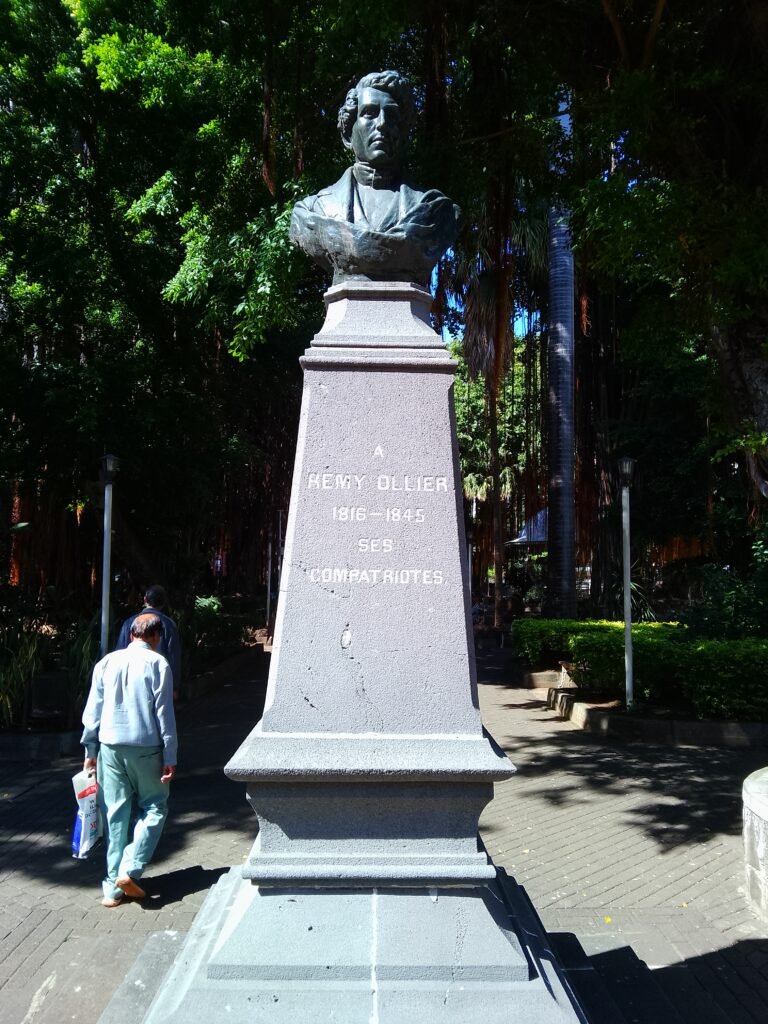
“Rémy Ollier — Symbol of Courage and Freedom”
🧑🏾⚖️ Rémy Ollier (1816–1845) — A Voice for Justice in Mauritius
Through his newspaper, “Le Cernéen,” Rémy Ollier fought peacefully for social justice, equality, and freedom of the press. He believed in unity and progress, and his bold words inspired many during a time of deep inequality.
Even though he passed away at just 29 years old, Rémy Ollier left behind a powerful legacy. Today, his statue stands proudly in the Jardin de la Compagnie in Port Louis — a reminder of the strength of ideas and the power of one voice to make a difference.
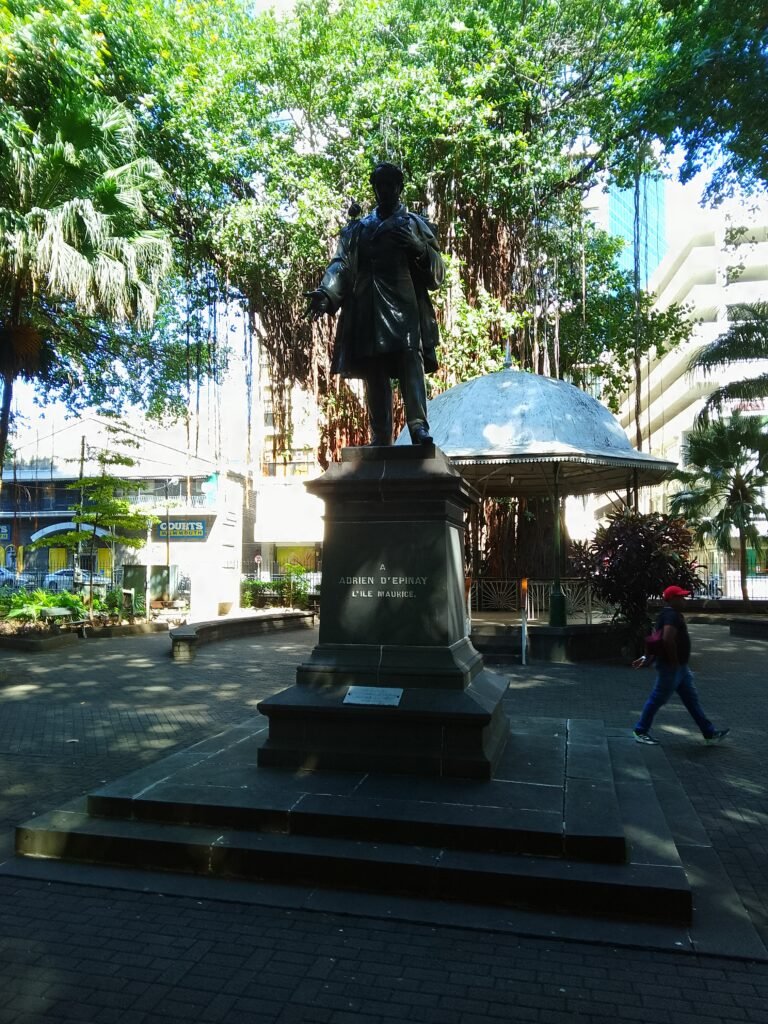
“Adrien d’Épinay — A Controversial Figure of Colonial Mauritius”
🧑🏻💼 Adrien d’Épinay (1794–1839) — The Voice of the Planter Class
Adrien d’Épinay was a wealthy Franco-Mauritian lawyer, politician, and newspaper owner during the early 19th century in Mauritius. Born in 1794, he played a major role in defending the interests of the sugar plantation owners during the time when slavery was being abolished in British colonies.
He founded the newspaper “Le Cernéen” and used it as a platform to speak out against the British government’s reforms, especially those that threatened the power of the colonial elite. While many remember him for his strong opinions and influence, his legacy is also connected to the controversial defense of slavery, which today is part of Mauritius’s complex and painful colonial history.
His statue still stands in the Jardin de la Compagnie, where history invites reflection. Adrien d’Épinay represents a powerful voice from the past — one that shaped the island’s political landscape during a time of great change.
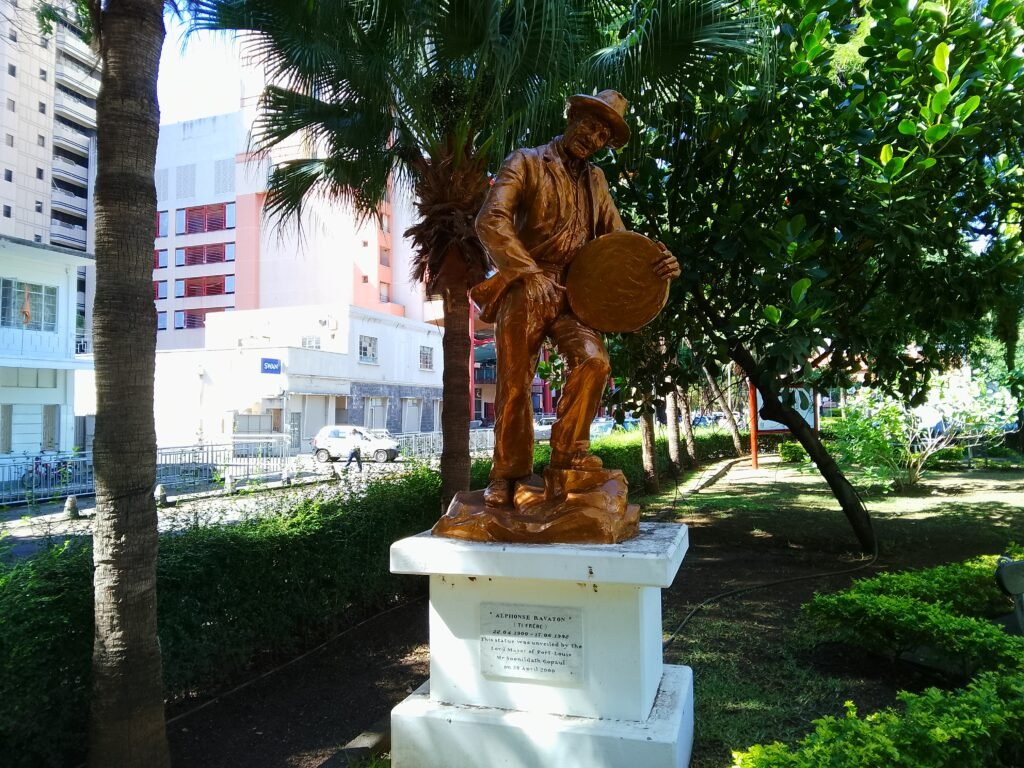
“Ti Frère — The King of Sega, Forever in Our Hearts 🇲🇺”
🥁 Alphonse Ravaton – “Ti Frère” (1900–1992)
The Undisputed King of Sega
Alphonse Ravaton, lovingly known as Ti Frère, was born on April 22, 1900, and became a true legend of Mauritian music. With his deep voice and the beat of the ravanne in his hands, he brought Sega to life in every corner of the island — not just as a dance, but as a voice for the people.
Coming from humble beginnings in Rose Hill, Ti Frère sang of love, suffering, freedom, and daily life. His songs were raw and emotional, filled with soul. During a time when Sega was looked down on by the elite, Ti Frère proudly gave it dignity and made it part of national identity.
His most famous songs, like “Tige Zamal”, “Mama Rosina”, and “Mo Mari Leker,” are still sung with joy today. He received the Grand Officer of the Order of the Star and Key of the Indian Ocean (G.O.S.K) for his cultural contribution.
Ti Frère passed away on June 17, 1992, but his voice still echoes through the ravannes, fire-lit nights, and hearts of all Mauritians. His statue stands in Jardin de la Compagnie — a symbol of pride, rhythm, and resistance.
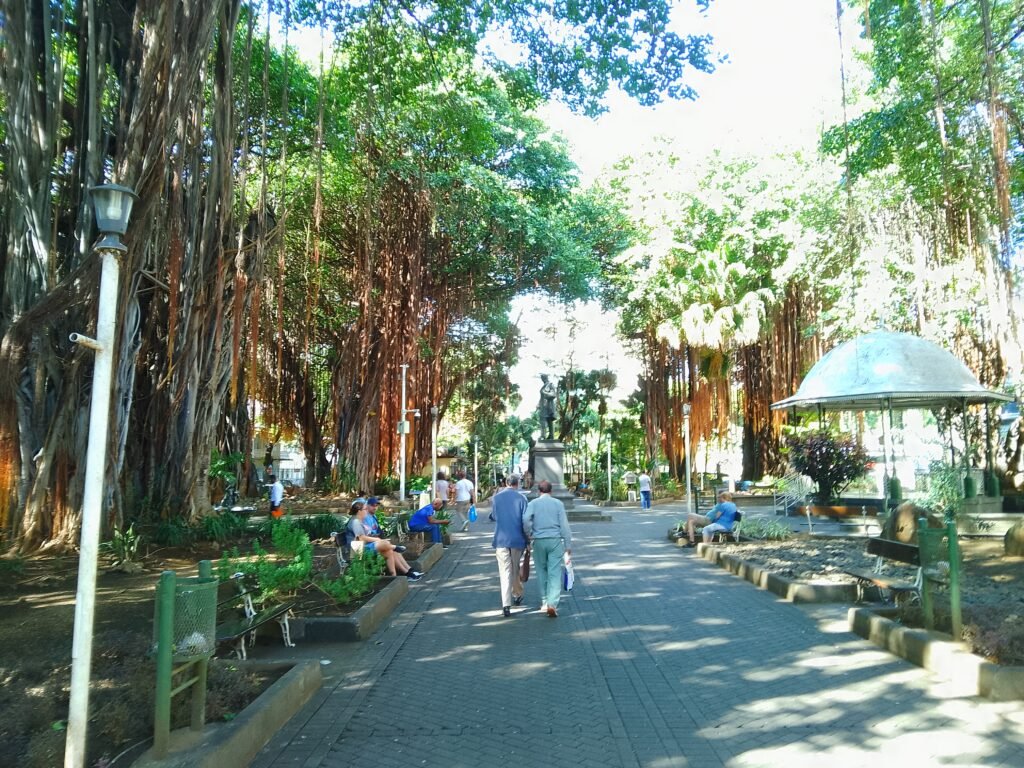
🌳 Jardin de la Compagnie — The Heart of Nature in Port Louis
Nestled in the bustling capital city of Mauritius, Jardin de la Compagnie is a peaceful green oasis that offers a breath of fresh air amid the urban rhythm. Established during the French colonial era, this historic garden features majestic ancient trees, vibrant tropical flowers, and serene walking paths that invite both locals and visitors to relax and enjoy nature’s beauty.
The garden is also a cultural landmark, home to several statues honoring Mauritius’s heroes, including Rémy Ollier, Adrien d’Épinay, and Ti Frère. It’s a living museum where history and nature blend perfectly, making it a must-visit spot in Port Louis.
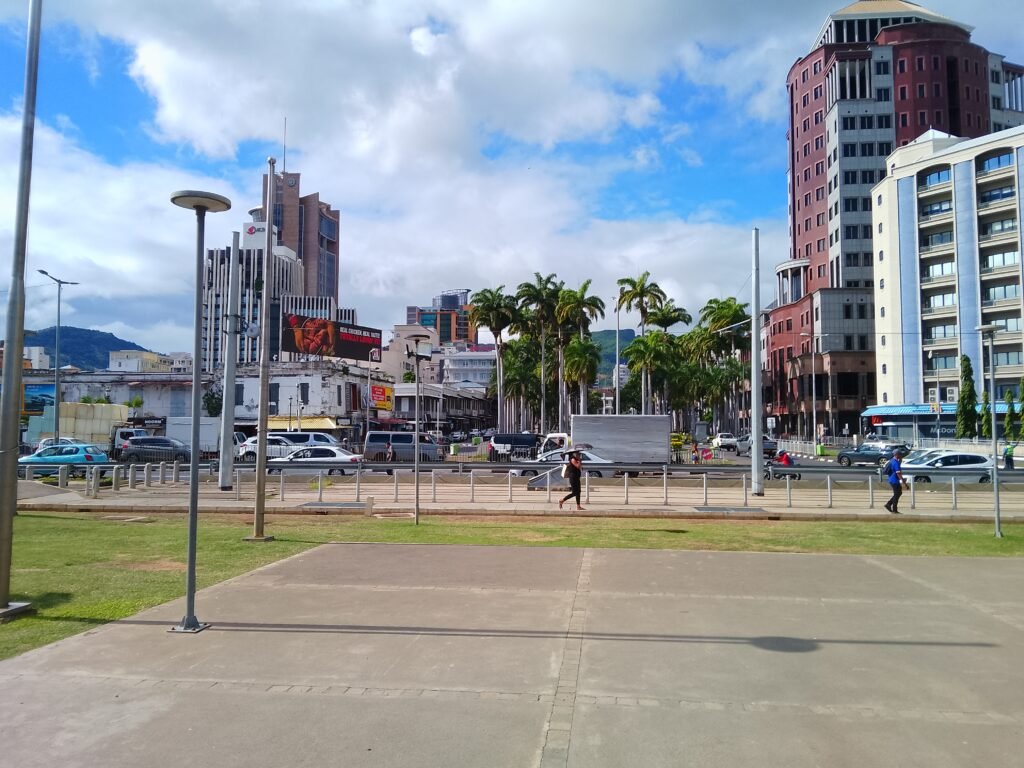
🏙️ Port Louis — The Vibrant Capital of Mauritius
As the political, economic, and cultural heart of Mauritius, Port Louis the capital of Mauritius stands as a vibrant melting pot of traditions and modernity. Founded in the early 18th century, the city has grown from a small French settlement to a bustling port and commercial hub.
Port Louis boasts a rich history visible in its colonial architecture, colorful markets like the Central Market, and important institutions such as the Government House and the Blue Penny Museum. The city’s waterfront buzzes with activity, blending business, tourism, and cultural festivals in a lively atmosphere.
From the calm greenery of Jardin de la Compagnie to the busy streets full of life and flavor, Port Louis is a city where the past and present coexist beautifully — offering an authentic experience of Mauritius’s diverse heritage.
Comment *

Leave a Reply